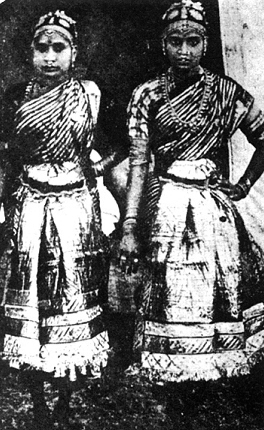|
No one can say when
Bharata Natyam was practised for the first time. There are many myths connected with the dance. It has been said that this dance form was called sadir. Some say that the term came from chaduru, a Telugu word, meaning ‘court’ or sabha. In that case, dances presented only in courts or sabha-s should have been called sadir, but this type of dance was prevalent in temples even before it entered the royal courts. In fact, sadir has another meaning: ‘beauty’. Saint Arunagirinathar says, “Sadiraayirunda Rati Maami” and saint Nammazhvar says, “Sadir ila madavaar” (meaning ‘beautiful young damsels’). The art of dancing that was very beautiful was called sadir. The devadasis-s, the custodians of this dance form, barring a few, did not call their art sadir. The famous dancer Pudukottai Ammalu Ammal signed her last will and testament as ‘Bharatanattiyam Pudukkottai Ammalu’.

The Kalyani daughters who
brought Bharata Natyam to the
Madras stage.
|
The name ‘Bharatam’ is said to have come down the ages from sage Bharata. The term bharata also means ‘a dancer’. This was very much in use in literature as well as in the conversations of devadasi-s. To quote some composers and scholars, Arunagirinathar refers to Bharatacchilambu and Vidhamigu bharatasura vanitaiyar. Kumaraguruparar’s Sakalakalavalli Malai speaks of Pannum Bharatamum. Seera Puranam of Umaru Pulavar says about Bharatam aadidamum Geetappannoli arangum. Inscriptions tell us that Kopperunchingan held the tile ‘Bharatam Valla Perumaan’ and one among many titles of Hoysala Vishnuvardhana was ‘Sakala Bharata Vidya Hridaya’. We can go on citing hundreds of such usages.
Next we come to the important issue of who coined the term Bharata Natyam.
The late Dr. Arudra, writing in Sruti (Dec.1986/Jan.1987), quoted Rukmini Devi (Kalakshetra Journal, Vol. XVII – 1977): “So far as I know, I was the first person, when I began to dance in the early 1930s, to give the (new) name to the dance and since then the word Bharata Natyam has been acceptable in common use.” He, however, questioned this statement. Rukmini Devi had her first real introduction to this art only on January 1, 1935. She recorded this fact (28th Conference Souvenir of the Music Academy). A person who, by her own admission, did not understand the art until after she encountered Meenakshisundaram Pillai and his disciples (Sabharanjitam and Nagaratnam) in 1935, could not have thought of naming it as Bharata Natyam earlier than that year.
Dr. V. Raghavan, during a dance seminar organised by the Central Sangeet Natak Akademi in Delhi, stated that he first started using the name Bharata Natyam and it soon became popular. Arudra wrote that Raghavan actually used the word Bharata Natya for the first time in his 1933 article titled Bharatanatya Classical Dance – The South Indian Nautch (in the background of the controversy over the art) (Sound and Shadow – Madras, Vol. II, Issue 6, 1933). A leading dancer wrote in The Hindu (7.12.1997) that “it was in the mid-thirties that E. Krishna Iyer first coined the term Bharatanatyam for the Sadir dance”.
There are numerous references to Bharata Natyam by earlier writers.
Palkuriki Somanatha in his Panditaaraadhya Charitamu mentions, “Bharatnatyamunu chakkaga nadipinchi”. Purandaradasa (15th Century), in his devaranama, Aadidano Ranga, clearly says: “Rambhe Oorvasi ramaniyarellaru chandadim Bharatanatyagala nadisi.” Vipranarayana Charitamu, a Yakshagana (1669) of King Vijayaraghava Nayaka of Thanjavur, says, “Devadevee devaraku Bharatanatya sangeetaadi vidyanna vinupinchu”. In the Tamil work Sokkanathasami Vannam (1685) we find this description: “Maruvum rasata sabhaiyul Bharata natanam idubavar Sokkar.” Mannip-padikkarani Kuravanji (1775) is another work that speaks about Bharata Natya: “Ati roopa mohana vanitaiyar abhinaya Bharatanattiyam puriya.” P. Raghavaiah Charry’s monograph, A Short Account of the Dancing girls treating concisely on the general principles of Dancing and Singing with the translations of the Hindo songs (dated 3.12.1806) states: “It is stated that Bharata nateya or dance of the devadasi should be composed of 5 Angas or parts.” When the wedding of Raja Bhaskara Setupati of Ramanathapuram took place on 13.5.1888, Ramalinga Kavi composed a Kumni and in that we find, “Singamidaiyotta Tangak Kanakambujam Sreerangam Janaki Nagarattinam paadagam tandai silambolikka vanda Bharatanattiyam neer kalikka”.
Records show that dancers also used the word Bharata Natya to describe their dance. Opposing the proposal of Dr. Muthulakshmi Reddy, a letter from Rudraganika Sangam, Madras, signed by Bangalore Nagaratnam, Salem Tayaramma, T.M. Krishnaveni and others, was sent on 5.11.1927 to the members of the Legislative Council. It mentions, “You will admit that many of us are devotees to the arts of music and Bharatanatya. A few of us are able to perform Kalakshepam to the public.” In 1910, a devadasi attached to the Ponnambalavanesar Temple, Colombo, wrote a book, Uruttira Ganikaiyar Kathasarat Tirattu in which, while giving her own bio-sketch, the author, K. Anjukam says, “... Easwara Varudam Tai 28 Vellikkizhamaiyanru, pottukkatti, Mayavaram Kandasami Nattuvanaridam Bharatanattiyappayirchi nadandadu...” Another devadasi attached to the Ulsoor Someswara temple, Venkatasundara Sani, in her work in Sanskrit (1908) wrote,“Someswarasya agresthitam Bharatanatyam karayet.”
Mahakavi Subramania Bharati wrote, “Paatum seyyulum kottiduveere – Bharatanattiyak kuttiduveere.” Poet Karai Muhammad Yusuf (1911) goes on to say: “Paangaana Bharatanattiyam ivarkku paramparaiyaal vanda sottu – ennai paaraamaley neerum nerunginaal podum – pocchudaioo umadu sottu,” in his Dasigalin Mosak Kummi.
The Dutchman, Jacob Haafner (1754/1809), who lived for more than thirteen years in India and Sri Lanka and spoke Tamil, wrote in his autobiography (1807) that he fell in love with a “Bharatanatya dancer” in 1786. A Jesuit missionary, who first used the term ‘devadasi’ in European literature, says (1713) that he baptised “a devadasi, who was a professional in Bharatanatyam”.
It is clear that the term Bharatanatyam was very much in use, at least from the 12th Century. So all other claims are false. (Courtesy: Sruti)
|